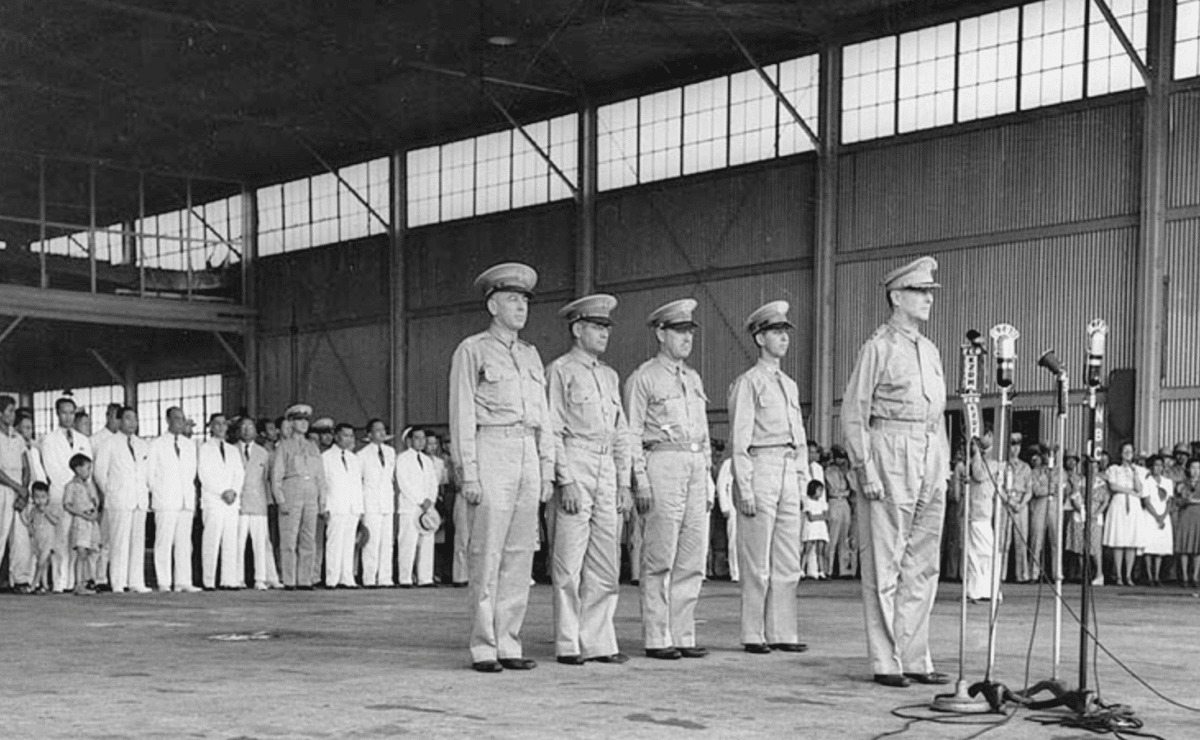Camp Murphy and Zablan Field become Camp Aguinaldo and Camp Crame

Senior officers lead a military ceremony at Camp Murphy. Photo from Wikipedia.
Camp Murphy was established on Jan. 11, 1935. The camp was located in Quezon City not far from Fort William McKinley. The land creating Camp Murphy had originally belonged to the Augustinian order. The camp was named after Frank Murphy, the last American Governor-General during American colonialism in the Philippines and the first American High Commissioner under the Philippine Commonwealth.
In 1934, the Tydings-McDuffie Act was approved by the United States Congress and signed by President Franklin D. Roosevelt. The act outlined the transitional steps and timeline to Philippine independence in 1946. On March 23, 1935, President Franklin Roosevelt approved the newly created Philippine Constitution.
The transitional steps to independence also included the creation of the National Defense Act of 1935. The act developed an independent Philippine military. Camp Murphy was established under the National Defense Act of 1935. The act also created the position of a Military Advisor to the Philippine Commonwealth. General Douglas MacArthur, the retiring Chief of Staff of the US Army, was given the position in October 1935. Major Dwight D. Eisenhower was the personal assistant to General MacArthur.
Within the grounds of Camp Murphy, an airfield was established. The field was named Zablan Airfield to honor Major Porfirio Zablan who died in a plane crash on June 17, 1935. On December 23, 1935, the site became the headquarters for the Philippine Army Air Corps.
The initial mission of the facility was to train pilots for the Philippine Constabulary Air Corps. Shortly, the primary mission was changed to train pilots for the Philippine Army Air Corps (PAAC). The Zablan airfield had intersecting sod runways.
A future five-star American general learned how to fly at Camp Murphy. Major Dwight D. Eisenhower, the assistant to the Military Advisor General Douglas MacArthur, woke up early in the morning from his unairconditioned room at the Manila Hotel to take flying lessons at Camp Murphy.
Eisenhower had wanted to join the US Army Air Corps shortly after his graduation from the US Military Academy at West Point, New York in 1915. The Air Corps offered Eisenhower excitement and a higher salary. When he broached the subject of flying to his future father-in-law, Mr. John Sheldon Doud, he was grounded immediately. Flying lessons at Camp Murphy and Zablan Field offered Eisenhower some newfound freedom and challenges.
As Japanese aggression increased throughout Southeast Asia in 1941, Camp Murphy and Zablan Airfield were transferred from PAAC to the Far East Air Force (FEAF) on Aug. 15, 1941. The Far East Air Force was subordinate to the newly created United States Armed Forces in the Far East (USAFFE). General Douglas MacArthur had recently been called back on active duty and was appointed the leader of USAFFE. He attended the Aug. 15, 1941, transfer ceremony of PAAC to FEAF at Camp Murphy and Zablan Field.
Zablan Field had 141 pilots who became members of the 6th Pursuit Squadron. The squadron had old P-26 airplanes made by Boeing. The planes were derisively called “peashooter.”
The Japanese air force attacked Zablan Field on Dec. 10, 1941. The raid was only three days after the attack at Pearl Harbor. There was significant damage to the airplanes and the airfield.
After the capture of Camp Murphy by the Imperial Japanese troops, the Japanese Army Air Force expanded and used the runways of Zablan Field. American Prisoners of War, who were living and working under horrible conditions, were detailed on work parties to expand the two intersecting runways at the airfield.
The former Camp Murphy and Zablan Field are used today by the Philippine Armed Forces and the Philippine National Police. The police were formerly known as the Philippine Constabulary. The old airfield is divided into two Philippine facilities separated by the congested and busy Epifanio de los Santos Avenue (EDSA).
On one side of EDSA is Camp Emilio Aguinaldo, which is used by the Philippine Armed Forces. President and General Emilio Aguinaldo was the leader of the independence movement and wars against Spain and the United States. The camp was named Camp Aguinaldo in 1965.
Camp Aguinaldo has an Armed Forces of the Philippines museum located on its site. The museum contains multiple dioramas and artifacts covering Camp Murphy and Zablan Field during pre-World War II, World War II and post-World War II.
On the other side of EDSA is Camp Crame. This camp is the home to the Philippine National Police. The camp is named after Brigadier General Rafael Crame who was the first chief of the Philippine Constabulary.
Dennis Edward Flake is the author of three books on Philippine-American history. He is a Public Historian and a former park ranger in interpretation for the National Park Service at the Eisenhower National Historic Site in Gettysburg, PA. He can be contacted at: flakedennis@gmail.com

